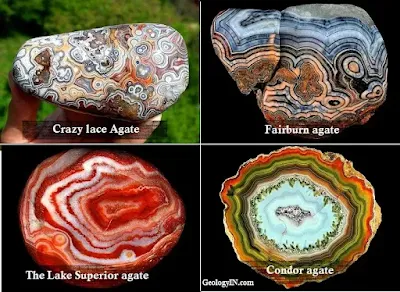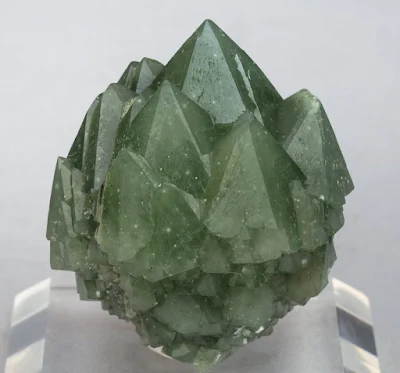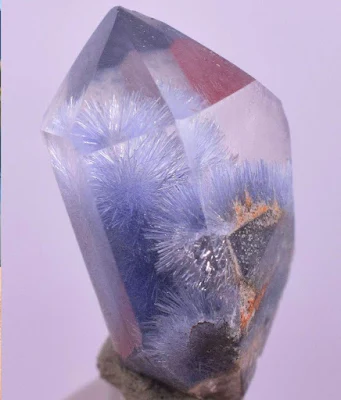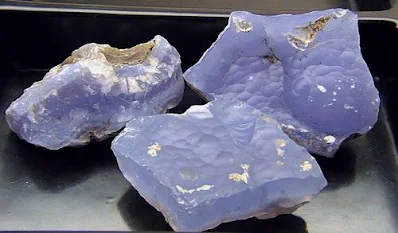Quartz: Types and Varieties of Quartz (Photos)
Quartz
Quartz is a hard, crystalline mineral composed of silicon dioxide (SiO₂). Quartz is one of the most common mineral on the face of the Earth. It is found in nearly every geological environment and is at least a component of almost every rock types: igneous, metamorphic, and sedimentary. It frequently is the primary mineral, >98%. It is also the most varied in terms of varieties, colors and forms.
The major varieties and types of quartz include rock crystal, amethyst, citrine, rose quartz, smoky quartz, ametrine, jasper, carnelian, and agate. These varieties of quartz are often used in jewelry and for ornamental purposes.
There are many different varieties of quartz, several of which are semi-precious gemstones. Since antiquity, varieties of quartz have been the most commonly used minerals in the making of jewelry and hardstone carvings, especially in Europe and the Middle East.
 |
| The Major Varieties of Quartz |
Some macrocrystalline (large crystal) varieties of quartz are well known and popular as ornamental stone and as gemstones.
- Amethyst is the purple gemstone variety.
- Citrine is a yellow to orange gemstone variety that is rare in nature but is often created by heating Amethyst.
- Milky Quartz is the cloudy white variety.
- Prasiolite is a leek-green gemstone variety that is rare in nature but is created by heating Amethyst from certain locations.
- Rose quartz is a pink to reddish pink variety.
- Smoky quartz is the brown to gray variety.
Cryptocrystalline (crystals too small to be seen even by a microscope) varieties are also used as semi-precious stones and for ornamental purposes. These varieties are divided more by character than by color.
The primary varieties of Cryptocrystalline quartz are as follows:
- Agate is a banded variety (sometimes with translucent bands)
- Bloodstone is green with red speckles
- Carnelian is yellow to orange
- Chrysoprase is green
- Flint is generally black with a fibrous microscopic structure
- Jasper is any colorful agate
- Onyx is black, white, or alternating black and white
- Sard is yellow to brown
- Sardonyx is banded, alternating sard and (usually white) onyx
Quartz Types and Varieties
Agate
 |
| Agate samples. |
Agate is a banded variety of chalcedony (microcrystalline quartz) recognized for its striking concentric or layered patterns in a wide range of colors. These bands form when silica-rich fluids repeatedly infiltrate cavities, fractures, or vesicles in volcanic rocks, depositing successive layers of chalcedony and quartz over long periods. Variations in trace elements, impurities, and crystallization conditions produce the distinctive color zoning that makes agate highly prized for jewelry, carvings, and ornamental objects.
Aventurine is a variety of quartz characterized by its shimmering, glittery appearance known as aventurescence, which is caused by tiny, reflective mineral inclusions. These inclusions are typically mica (such as fuchsite, a chromium-rich muscovite) that impart a green color, though hematite, goethite, or other minerals can produce shades of red, orange, brown, blue, or gray. Aventurine forms when silica-rich fluids precipitate microcrystalline quartz in veins, cavities, or massive aggregates, trapping these reflective platelets within the quartz during crystallization. The most common and valued color is a rich, sparkling green, often linked to fuchsite inclusions derived from the alteration of ultramafic or metamorphic host rocks.
Hematite Quartz
 |
| Hematite (ferruginous) quartz - red quartz |
Hematite quartz, also known as ferruginous quartz, is a type of quartz that contains iron oxide (hematite) inclusions or impurities. These inclusions can impart a range of colors, including red, orange, and brown, and often give the quartz a rusty or metallic appearance. The hematite can create unique patterns or inclusions within the quartz, making each specimen distinct. This type of quartz is valued for its striking appearance and is often used in jewelry and decorative items.
Ferruginous Quartz is found in many parts of the world, including Brazil, Madagascar, and the United States. Ferruginous quartz is used in jewelry and other decorative objects.
Prase Quartz
 |
| Prase Quartz - green quartz |
Prase Quartz is a green variety of quartz, and its color is attributed to the presence of actinolite or chlorite inclusions. The green hue can range from light to dark green, and the inclusions often create unique patterns. The name "prase" is derived from the Greek word for leek, referring to the green color. It is found in many parts of the world, including Germany, Australia, and the United States. Prase quartz is used in jewelry and other decorative objects.
Amethyst
 |
| Amethyst Photo by @luminous.element |
Amethyst is the purple variety of quartz and is a popular gemstone, renowned for its vivid violet to deep purple hues caused by trace amounts of iron within the crystal lattice and subsequent natural irradiation, which creates color centers. Amethyst commonly forms as crystals lining cavities in volcanic rocks, such as geodes and vugs, or in hydrothermal veins where silica-rich fluids crystallize slowly at moderate temperatures. Amethyst is a semiprecious stone and is the traditional birthstone for February.
Rutilated Quartz
 |
| Quartz with Rutile inclusions from Novo Horizonte, Bahia, Northeast Region, Brazil Copyright © Rob Lavinsky |
Rutilated quartz is a type of quartz that contains acicular (needle-like) inclusions of rutile. It is used for gemstones. These inclusions mostly look golden, but they also can look silver, copper red or deep black. They can be distributed randomly or in bundles, which sometimes are arranged star-like, and they can be sparse or dense enough to make the quartz body nearly opaque. While otherwise inclusions often reduce the value of a crystal, rutilated quartz is valued for the quality and beauty of these inclusions.
Citrine
 |
| Citrine faceted gem from Minas Gerais, Brazil. |
Citrine is the yellow to golden-brown variety of quartz, prized for its warm, transparent color that ranges from pale lemon to deep amber. Its coloration is usually due to trace amounts of iron impurities that have been oxidized within the crystal structure, either naturally or through heat treatment of amethyst or smoky quartz. Natural citrine typically forms in igneous and metamorphic environments, particularly in granitic pegmatites and hydrothermal veins. However, natural citrine is relatively rare. Most citrine on the market today (around 95%) is created through heat treatment of amethyst or smoky quartz. With its vitreous luster, clarity, and Mohs hardness of 7, citrine is a durable and attractive gemstone often cut into faceted stones for jewelry.
Prasiolite
 |
Raw natural prasiolite
|
Prasiolite, also known as vermarine or green quartz, is a rare green variety of quartz (SiO₂) valued for its soft, translucent green color. The name comes from the Greek prason (leek) for its leek-like hue. Natural prasiolite forms when amethyst- or citrine-bearing quartz undergoes heat and, in some cases, natural irradiation, which alters the oxidation state of trace iron impurities within the crystal lattice to produce the green coloration. Most prasiolite on the market is not naturally occurring but is created by carefully heating certain amethyst deposits, particularly those from Brazil, to temperatures around 500 °C. True natural prasiolite is extremely rare and has been reported from limited localities, including parts of Brazil and Poland.
Rose Quartz
 |
| Rose quartz |
Rose quartz is a pink variety of quartz known for its soft, translucent to nearly opaque appearance. The pink hue is primarily attributed to trace amounts of titanium, iron, or manganese, and in some cases, microscopic fibrous inclusions of a mineral similar to dumortierite. These inclusions can also cause a faint asterism. Unlike amethyst or citrine, rose quartz almost always occurs in massive form rather than as well-formed crystals. It typically forms in pegmatites and hydrothermal veins, where silica-rich fluids crystallize. Its delicate color, vitreous luster, and durability (Mohs hardness 7) make it a popular gemstone for beads, cabochons, and carvings.
Milky Quartz
 |
Milky Quartz Cluster
|
Milky Quartz is a common variety of quartz distinguished by its cloudy, white appearance caused by abundant microscopic fluid or gas inclusions and minute fractures that scatter light. Milky quartz is the most common variety of crystalline quartz. It forms in a wide range of geological environments, including hydrothermal veins, pegmatites, metamorphic rocks, and granitic intrusions, where rapid crystallization traps fluids within the growing quartz. Milky quartz is among the most abundant quartz types and is often found as massive veins or large crystals. While less valued as a gemstone, it is widely used in industrial applications and as a decorative stone.
Smoky Quartz
 |
| Smoky Quartz with Amazonite from Colorado, USA |
Smoky quartz is the brown to black, and sometimes smoky gray version of quartz. It ranges in clarity from almost complete transparency to a brownish-gray crystal that is almost opaque. Smoky quartz, a variety itself of quartz, has a few varieties of its own. Read about it here.
Smoky quartz's smoky hues aren't caused by iron impurities, like citrine's yellow. Instead, natural radiation exposure is the key player. When quartz crystals are exposed to radiation from surrounding rocks or cosmic rays, it creates color centers within the crystal lattice. These color centers are responsible for the smoky gray to brownish-black shades we see.
 |
| Dumortierite Quartz |
Dumortierite Quartz is a type of quartz that contains inclusions of dumortierite, a blue mineral. The blue color can vary from light to dark blue, and the inclusions often form fibrous or needle-like structures within the quartz crystals. It is found in only a few places in the world, including Brazil, Namibia, and Madagascar. Dumortierite quartz is used in jewelry and other decorative objects.
Chalcedony
 |
| Chalcedony |
Chalcedony is a cryptocrystalline quartz. It's known for its smooth, waxy, or dull luster and can occur in a wide range of colors. Chalcedony often forms in nodules or concretions and can fill cavities in rocks. Its microcrystalline structure makes it distinct from larger quartz crystals. Due to its durability and attractive appearance, chalcedony is commonly used as a semi-precious gemstone in jewelry and decorative items.
Carnelian
 |
| Polished Carnelian |
Carnelian is a reddish to reddish-orange variety of chalcedony (microcrystalline quartz) valued for its warm, translucent glow and smooth, vitreous luster. Its color comes from finely dispersed iron oxides, primarily hematite, which form during the slow oxidation of iron-bearing solutions within silica-rich environments. Carnelian typically develops in volcanic rocks, sedimentary deposits, or hydrothermal veins, where silica-rich fluids precipitate microcrystalline quartz at low temperatures. Similar to carnelian is sard, which is generally harder and darker.
Onyx
 |
| Onyx contain bands of black and/or white. Copyright © Rob Lavinsky |
Onyx is a type of cryptocrystalline quartz, often characterized by its banded or layered patterns in various colors, typically black and white. It's a form of chalcedony, known for its smooth, glossy appearance and fine grain. Onyx is commonly used in jewelry, decorative objects, and carvings due to its attractive appearance and durability. The banded patterns can vary, and onyx can also occur in other colors, including red, green, or brown, depending on the presence of impurities or mineral inclusions.
Tiger's Eye
 |
| Polished tiger's eye gemstone |
Tiger’s Eye is a golden- to reddish-brown variety of quartz distinguished by its silky, chatoyant (cat’s-eye) sheen. This optical effect results from the pseudomorphic replacement of crocidolite (blue asbestos) by quartz, a process in which quartz gradually replaces the fibrous amphibole while preserving its parallel, fibrous structure. Iron oxides within the fibers impart the characteristic golden to brown coloration, while variations in oxidation can create red tiger’s eye (also called “bull’s eye”). Tiger’s eye typically forms in metamorphosed banded iron formations and quartz veins where silica-rich fluids infiltrate and replace crocidolite. An incompletely silicified blue variant is known as hawk's eye.
Mtorolite
 |
| Mtorolite zimbabwe |
Mtorolite is a rare, chromium-rich variety of chalcedony, a microcrystalline form of quartz (SiO₂), known for its distinctive rich green color. The striking green hue results from trace amounts of trivalent chromium substituting into the chalcedony structure during formation, similar to the coloring mechanism in emerald and chrome chalcedony. Mtorolite typically occurs as botryoidal (grape-like) masses, nodules, or vein fillings within serpentinite, ultramafic rocks, and weathered chromite-bearing deposits, where silica-rich fluids interact with chromium-bearing minerals under low-temperature conditions. This variety derives its name from the Mtoroshanga chromite mines in Zimbabwe, the classic locality where it was first described, although similar material has been found in Poland, Turkey, and a few other locations. Its vibrant color, waxy luster, and fine translucence make mtorolite a desirable gemstone and lapidary material, often cut into cabochons or beads for jewelry.
Chrysoprase
 |
| Chrysoprase from Australia. Photo by: Australian Outback Mining |
Chrysoprase is a microcrystalline form of quartz, distinguished by its vibrant apple-green color. This distinctive hue is caused by traces of nickel, which sets it apart from other green gemstones. The nickel is typically derived from the weathering of ultramafic rocks such as serpentinite or lateritic nickel ores. Chrysoprase commonly forms in veins, nodules, or as fillings in fractures within silica-rich environments where nickel-bearing solutions precipitate microcrystalline quartz at low temperatures. The finest specimens display a bright, uniform green color and a smooth, waxy luster, qualities that have made chrysoprase a prized ornamental stone since antiquity, used in Greek, Roman, and later European jewelry and carvings.
Jasper
 |
| Rough of Kaleidoscope Jasper from Oregon |
Jasper is an opaque, fine-grained variety of chalcedony that owes its wide array of red, brown, yellow, or green colors to finely dispersed iron oxides, clays, or other mineral inclusions. Unlike the translucent banding of agate, jasper is typically massive and patterned with spots, swirls, or brecciated textures, often reflecting the composition of the host rock. It forms as a secondary silica deposit in sedimentary and volcanic environments, commonly replacing or cementing other materials. Because of its opacity, rich patterns, and polishability, jasper has been used for cabochons, beads, mosaics, and ornamental carvings since antiquity.
Heliotrope / Bloodstone
 |
Heliotrope, commonly known as bloodstone.
Photo courtesy of R. Weller |
Heliotrope, commonly known as bloodstone, is a dark green variety of chalcedony (microcrystalline quartz) characterized by distinctive red or reddish-brown spots of iron oxide or jasper that resemble drops of blood, giving the stone its dramatic appearance and name. The green color results from finely dispersed inclusions of chlorite or amphibole minerals, while the red specks form when iron-bearing fluids oxidize within fractures or cavities during or after chalcedony deposition. Bloodstone typically forms as nodules, veins, or pebbles in silica-rich environments such as hydrothermal veins, basalt cavities, or weathered metamorphic rocks, where silica-rich solutions precipitate cryptocrystalline quartz at low temperatures. Prized since antiquity for its striking contrast of colors, bloodstone was used for seals, amulets, and carved intaglios in ancient India, Greece, and Rome, and it remains a popular gemstone for cabochons, beads, and ornamental carvings.
Finally
All these varieties of quartz are appreciated in the world of mineral and crystal enthusiasts for their unique colors, inclusions, and visual appeal. Each type has its own geological origin and formation process, contributing to the diversity of quartz specimens found in nature.





%20(1).webp)



